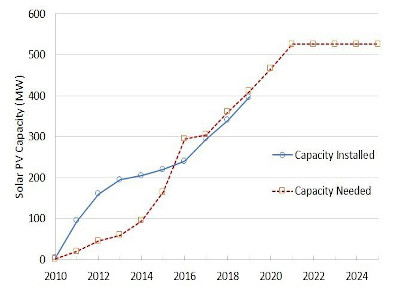By EDWARD JOHNSTONBAUGH
Several interesting developments have been affecting the prospects for solar power in Pennsylvania as of late. This includes issues related to the AEPS (Alternative Energy Portfolio Standards) act as well as talk of community solar.
Harrisburg Rumblings
It wasn’t that long ago the AEPS legislation was signed and went into effect. Looking into the distant future, back then, many folks were quite certain that we’d sail right past the benchmark for Solar PV capacity that was set at one half of one percent by the year 2021. Here we are at the start of 2020, the year the AEPS sunsets, looking at a very high likelihood that we won’t achieve that minimal goal. The most recent annual report from the Public Utility Commission (PUC), released in December 2019, shows the total of installed capacity of Solar PV stood at 324 MW (year ending 2018). The estimate for installed capacity required to meet the ½ of 1 percent mandate was at 700 MW. Allowing that 2019 saw another significant increase in Solar PV installed capacity it is still most likely that we’ll miss the legislative mandate by a significant margin. However, credit prices continue to strengthen, in part due to efforts of groups such as the Future Times Energy power collective, which has been pushing on credit prices, and in turn causing solar to be more attractive to all. As the chart shows, now that the market is transitioning from reliance on out-of-state SRECs (Solar Renewable Energy Credits) to in-state credits the installed capacity is lagging the demand. If this condition persists or even grows wider the possibility of a credit price spike becomes real. While a spike in prices may sound like a good thing, if that occurs the likelihood of a legislative knee jerk reaction could come into play. Those types of corrections often do more harm than good. The best prescription is a slow recovery that restores health of the renewable energy credit marketplace for the long term.

Sunset on the AEPS Act
As the year 2020 gets underway its timely to gauge the success of the last 15 years in diversifying the electric generation market away from fossil fuels in favor of clean sustainable energy sources. The largest change in that time has been the growth of natural gas to the position as the dominant fuel in the PA market, That doesn’t overshadow the growth of Solar PV, and the other categories of renewable energy from a position of non-existent to a growing presence in the wholesale generation market. But what does the future hold for clean and sustainable energy sources in PA? Legislative bills in consideration in Harrisburg support continuation of the growth at an accelerated pace. Proposals include expanding the capacity for Solar PV from the present marginal level to 10% by the year 2030. Of the 10%, 7.5% would be dedicated to utility scale solar with the balance committed to Behind-the-Meter solar PV. The dividing line between utility scale solar PV is 5 megawatts, although projects can far exceed that level and spread over a hundred or more acres. If new legislation is not put in place the organic growth of the electricity market will expand the slice of the pie but only incrementally since the historic market growth trend is about 2% per year.
Community Solar PV
A second bill making the rounds again this year would end PA’s prohibition on Community Solar. In the classification of “stimulating innovation” Community Solar PV comes in many different flavors, where its allowed, varying from state to state and between Local Distribution Companies, Rural Electric Coops, and Municipal Electric Authorities. The draft legislation, like much of what goes into the public policy grinder originated from one or more Washington D. C. based special interest groups. The policy template that’d been enacted in other states attempts to be a one size fits all solution. As such it has square peg features that don’t align completely with the round holed nature of PA policy. Nonetheless, this approach will have much of what is needed for Community Solar PV to gain a foothold. What will be cumbersome is pushing it through the policy filters of log standing agencies.
Community Solar, in its unadulterated concept allows a single solar PV plant to be built and connected to the grid.. The generation output in the form of kilowatt-hours are assigned monthly to subscribers based on the size of their subscription. For example, if a subscriber subscribes 2 modules out of a 100 module solar PV system then 2% of all the electricity from the system would be credited to the subscribers bill each month. This allows renters or those who live in solar PV unfriendly locations to opt-in to solar PV at the level of their choosing. It also allows those who can’t make the financial leap to buy in at an incremental level. The challenge will likely come with adapting billing systems.
Limitations on Community Solar will come from two areas. One will be the project developer who will set the subscription cost and limit the maximum size of the subscription. Other parameters of the deal will vary from project to project. The other limitation will come from the Load Serving Entity who will have to provide the means of crediting the energy from the community to a large number of subscribers and keep everything straight.
It will be interesting to see how these trends develop over the course of the year, and to mark how they impact opportunities for the growth of solar power.
Source : psu.edu